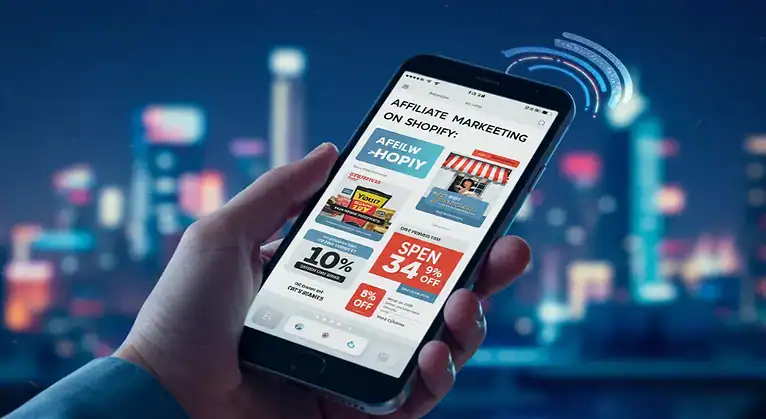How Affiliate Marketing Works: A Beginner’s Guide [2025]
Are you looking to become an affiliate partner? start affiliate marketing but don’t know where to begin? This guide will help you become a successful affiliate marketer, even if you have no money to start. We’ll cover the ins and outs of affiliate marketing, how to get started, and provide actionable tips to help you succeed in this lucrative field.
-
- Start an Affiliate Journey: Affiliate marketing is a way for individuals to make money with affiliate marketing by promoting products or services.
- Building an Affiliate Platform: To build an affiliate site, choose a niche, create valuable content, and include affiliate links to attract potential buyers.
- Earning Potential: The annual salary of an affiliate can vary; involved affiliate marketers can significantly increase their earnings through effective campaigns.
- Ways to Do Affiliate Marketing: Use different marketing methods, such as blogs and social media, to promote affiliate products and get your affiliate links out there.
- Commission Structures: Affiliate marketing involves various ways an affiliate is paid, including pay-per-sale and pay-per-lead models.
- Learning from Experts: Marketer Pat Flynn categorized affiliate marketing strategies that help aspiring affiliates succeed in this lucrative field.
How does Affiliate Marketing Work?
Affiliate marketing is a performance-based business model where individuals (affiliates) earn a commission for promoting products or services from other companies. Here’s a concise overview of the process:
- Sign Up: Affiliates join an affiliate program of a company that offers products or services.
- Unique Links: Affiliates receive unique tracking links to share on their platforms, like blogs, social media, or websites.
- Promotion: Affiliates promote these links through content, reviews, or advertisements to drive traffic.
- Customer Action: When a customer clicks the link and makes a purchase, the affiliate’s unique ID tracks the sale.
- Commission: The company pays the affiliate a percentage of the sale as a commission, which can vary based on the product or service.
- Payment: Affiliates receive their earnings through the payment methods specified by the affiliate program.
This model benefits both companies and affiliates, as companies gain sales while affiliates earn income without holding inventory.
What is Affiliate Marketing?
Affiliate marketing is a performance-based marketing model where businesses reward affiliates for driving traffic or sales to their products or services, often through affiliate sales. As an affiliate marketer, you earn a commission for each sale or lead you generate through your unique affiliate links.
The Key Players in Affiliate Marketing
- Merchant: The company or individual selling the product or service.
- Affiliate: The promoter (you) who markets the merchant’s offerings.
- Customer: The end-user who purchases the product or service.
- Affiliate Network: A platform that connects merchants with affiliates (e.g., Amazon Associates, ShareASale, ClickBank).
How to Start Affiliate Marketing
Starting your journey as an affiliate marketer is easier than you might think. Here’s a step-by-step guide to help you get started with affiliate marketing:
- Choose Your Niche: Select a topic you’re passionate about and that has profit potential.
- Research Affiliate Programs: Find affiliate programs related to your niche.
- Build Your Platform: Create a website, blog, or social media presence.
- Produce Valuable Content: Create high-quality content that attracts your target audience.
- Incorporate Affiliate LinksStrategically place your affiliate links within your content to maximize affiliate sales.
- Drive Traffic: Promote your content to attract visitors.
- Analyze and Optimize Monitor your performance in affiliate marketing work and make improvements.
How Affiliate Marketers Get Paid
Affiliate marketers can earn money through various commission structures:
- Pay-per-sale (PPS): Earn a percentage of each sale you generate.
- Pay-per-lead (PPL): Get paid for each lead you send to the merchant.
- Pay-per-click (PPC): Earn money for each click on your affiliate link.
Affiliate Marketing for Beginners: Tips for Success
To become a successful affiliate marketer, consider these tips:
- Choose the Right Products: Promote products you believe in and have personally used.
- Build Trust: Be honest and transparent with your audience about your affiliate relationships.
- Diversify Your Income Streams: Don’t rely on a single affiliate program or product.
- Create Valuable Content: Focus on helping your audience solve problems.
- Stay Up-to-Date: Keep learning about new marketing strategies and industry trends.
- Use Email Marketing: Build an email list to nurture relationships with your audience.
- Leverage social media for effective content marketing strategies.: Use platforms like Instagram, YouTube, and TikTok to reach a wider audience.
Affiliate Marketing with No Money: Getting Started on a Budget
You can start affiliate marketing with little to no upfront investment:
- Use Free Blogging Platforms: Start with platforms like Medium or WordPress.com.
- Leverage Social Media: Build a following on free social media platforms.
- Create YouTube Content: Start a YouTube channel to review products and share affiliate links.
- Join Free Affiliate Networks: Many networks don’t charge to join as an affiliate.
- Utilize Free SEO Tools: Use tools like Google Keyword Planner to optimize your content.
Successful Affiliate Marketing Strategies
To maximize your affiliate marketing efforts:
- Conduct thorough product research to find the best affiliate offers.: Understand the products you’re promoting inside and out.
- Create In-Depth Reviews: Provide honest, detailed reviews of affiliate products.
- Use Comparison Tables: Help your audience make informed decisions by comparing similar products.
- Offer BonusesIncentivize purchases through your affiliate links by offering exclusive bonuses for those who make a purchase.
- Optimize for Search Engines: Use SEO techniques to increase your organic traffic.
- Track Your Results: Use analytics tools to monitor your performance and identify areas for improvement.
Building Your Affiliate Marketing Business
- Choose a Niche: Select a topic you’re knowledgeable and passionate about.
- Research Affiliate Programs: Find programs that align with your niche and audience.
- Create a Marketing Channel: Build a website, blog, YouTube channel, or social media presence.
- Produce High-Quality Content: Create valuable content that attracts and engages your target audience.
- Build an Audience: Consistently create content and engage with your followers to grow your audience.
- Promote Affiliate Products: Strategically incorporate affiliate links into your content.
- Analyze and Optimize: Regularly review your performance and make data-driven improvements.
Types of Affiliate Marketing Programs
- Unattached affiliate marketing can be a challenge in digital marketing.Promoting products without a direct connection to your niche or audience can hinder your affiliate marketing work.
- Related Affiliate Marketing: Promoting products that are related to your niche but not directly used by you.
- Involved Affiliate Marketing: Promoting products you personally use and recommend.
Popular Affiliate Networks and Programs
- Amazon Associates: The largest affiliate program offering a wide range of products.
- ShareASale: A diverse network with thousands of merchant programs.
- ClickBank: Focused on digital products and online courses.
- CJ Affiliate: A well-established network with many reputable brands.
- Rakuten Advertising: Offers high-quality merchant programs across various industries.
Affiliate Marketing Tools and Resources
- Google Analytics: Track website traffic and user behavior.
- Pretty Links: Create clean, branded affiliate links.
- AAWP (Amazon Affiliate WordPress Plugin): Easily add Amazon product information to your site.
- Canva: Create visually appealing graphics for your content.
- Mailchimp: Build and manage your email marketing campaigns.
Successful Affiliate Marketers to Learn From
- Pat Flynn (Smart Passive Income): Focuses on blogging and online business.
- Michelle Schroeder-Gardner (Making Sense of Cents): Specializes in personal finance.
- John Lee Dumas (Entrepreneurs on Fire): Podcasting and entrepreneurship expert.
- Adam Enfroy: Teaches blogging and affiliate marketing strategies.
FAQs About Affiliate Marketing
Q: What is affiliate marketing and how does it work?
Affiliate marketing is a digital marketing strategy where individuals or businesses (affiliate marketers) promote affiliate products or services and earn a commission for each sale or action generated through their marketing efforts. This involves joining an affiliate program and using affiliate links to track conversions.
Q: How can I become an affiliate marketer?
A: To become an affiliate marketer, you need to choose a niche, find an affiliate program that aligns with your interests, sign up for the program, and start promoting your affiliate links through various marketing channels such as blogs, social media, or email marketing.
Q: What are some effective affiliate marketing tips for beginners?
Some effective affiliate marketing tips include selecting quality affiliate products, focusing on a targeted audience, using SEO strategies to drive traffic, creating valuable content, and analyzing your affiliate campaigns to optimize performance.
Q: Can I get started with affiliate marketing without a website?
A: Yes, you can start affiliate marketing without a website by using social media platforms, YouTube, or email marketing to share your affiliate offers. However, having a website can provide a more professional platform for your affiliate links and content.
Q: What are the main types of affiliate marketing?
A: The main types of affiliate marketing include pay-per-sale (PPS), pay-per-click (PPC), and pay-per-lead (PPL) models. Each type involves different ways of earning affiliate income based on the actions taken by your audience.
Q: How do affiliate marketers make money?
Affiliate marketers make money by earning affiliate commissions for each sale or lead generated through their affiliate links. The commission structure varies depending on the affiliate program and can range from a percentage of the sale to a fixed amount per lead.
Q: What skills do I need to develop to succeed in affiliate marketing?
A: To succeed in affiliate marketing, you should develop marketing skills such as content creation, SEO, social media marketing, email marketing, and analytics to track and optimize your affiliate campaigns effectively.
Q: How can I promote my affiliate links effectively?
A: You can promote your affiliate links effectively by using high-quality content that provides value to your audience, leveraging influencer marketing, utilizing social media ads, and engaging in community discussions related to your niche.
Q: What is an affiliate program, and how do I choose one?
An affiliate program is a partnership between an affiliate marketer and a business that offers commission for promoting their products or services. When choosing an affiliate program, consider factors such as commission rates, product relevance, reputation, and support provided by the affiliate marketing partners.
Q: How can I track my affiliate marketing performance?
A: You can track your affiliate marketing performance by using analytics tools provided by your affiliate program or third-party tools like Google Analytics. These tools help you monitor clicks, conversions, and overall affiliate income to assess the effectiveness of your campaigns.
Conclusion: Your Journey as an Affiliate Marketer Begins
Affiliate marketing offers a fantastic opportunity to build a profitable online business. By following the strategies and tips outlined in this guide, you’ll be well-equipped to join an affiliate program and start your affiliate marketing journey. Remember, success in affiliate marketing requires patience, persistence, and a commitment to providing value to your audience. Stay focused, keep learning, and don’t be afraid to experiment with different approaches as you grow your affiliate marketing business.
With dedication and the right strategies, you can turn affiliate marketing into a lucrative income stream, potentially even replacing your full-time job. So, take the first step today and start building your affiliate marketing empire!
Learn more about affiliate marketing tips for beginners to enhance your online marketing efforts to kickstart your journey to success.
Resources:
-
- The Ultimate Guide to Affiliate Marketing in 2024 by Influencer Marketing Hub
Comprehensive guide covering basics to advanced strategies. - How to Succeed in Affiliate Marketing 2024 by Outbrain
Practical tips and strategies for affiliate marketing success in 2024. - Beginner Affiliate Marketing To Start In 1 Day – 2024 by Udemy
Online course teaching strategies to start affiliate marketing quickly. - What Is Affiliate Marketing? Everything You Need to Know in 2024 by Shopify
Explains fundamentals and provides tips for getting started. - 15+ Affiliate Marketing Strategies to Drive Sales in 2024! by Xperiencify
Practical strategies for successful affiliate marketing. - Affiliate Marketing: Tips, Tricks, and Best Practices for 2024 by Backlinko
Comprehensive guide on getting started and managing affiliate campaigns. - 45+ of the Best Affiliate Marketing Programs for Beginners in 2024 by AdvertisePurple
List of top affiliate programs across various industries for beginners.
- The Ultimate Guide to Affiliate Marketing in 2024 by Influencer Marketing Hub
I’m Alexios Papaioannou, an experienced affiliate marketer and content creator. With a decade of expertise, I excel in crafting engaging blog posts to boost your brand. My love for running fuels my creativity. Let’s create exceptional content together!











